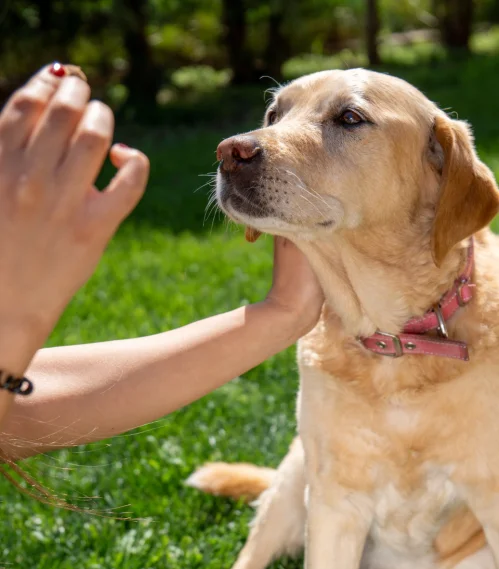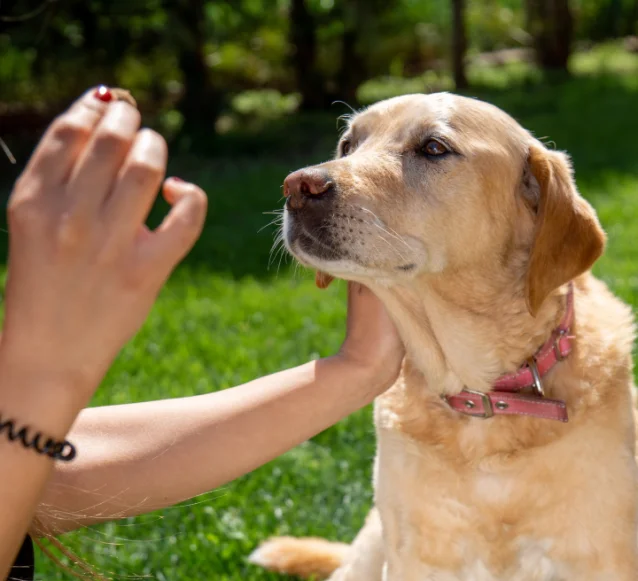Last Updated: 05/06/2025
Labrador Retriever Breed Guide
Learn all about one of the world's most popular dog breeds, the Labrador Retriever.
Author: Dr Teagan Lever BVSc (Hons)
Reading Time: 29 minutes - medium read
A favoured breed in many countries worldwide, the Labrador Retriever has a friendly, eager to please and sweet nature making it a fantastic family dog. This incredibly versatile breed is well suited to a range of disciplines including obedience, hunting and agility. Labradors are also often used as service, search and rescue dogs and detection dogs.
All about Labrador Retrievers
Place of origin
Canada
Weight range
24.9-36.3kg
Breed size
Large
Height range
56.6-62.2cm
Breed group
Retrievers
Life expectancy
10-12 years
Coat colours
Yellow, Black, Chocolate
Grooming needs
Low
Coat type
Short, double coat
Health issues
Obesity, osteoarthritis, hip dysplasia, elbow dysplasia
Shedding factor
Moderate
Exercise needs
Daily walks and play essential
Play style
Fetch, water play, puzzles
Housing needs
Adaptable if activity needs are met
Trainability
High, very food motivated
Social needs
Moderate
Family suitability
Excellent with all ages
Tendency to bark
Low



Nutrition
Feeding a high quality diet that is tailored to your Labrador's age and size will help to keep them healthy and happy. Getting nutrition right can help to prevent, reduce or manage some commonly occurring health conditions in Labradors such as obesity in adults or developmental bone and joint diseases in puppies.
Best food for adult Labradors
Labradors absolutely adore food! This makes them easy to train but also makes it easy to overfeed them, resulting in excess weight gain and obesity. Diets with a modified energy content and additional levels of fibre and protein to help promote satiety between meals can help to prevent this. Slowing down the rate of eating using tailored kibble or using a treat dispensing toy as a feeder is another good way to stretch out mealtime and reduce begging behaviour. Pay close attention to the feeding guidelines and check your dog's weight and body condition regularly to ensure you're not overfeeding.
As a breed predisposed to joint issues such as hip dysplasia, elbow dysplasia and osteoarthritis, feeding a diet with added beneficial ingredients such as glucosamine, chondroitin, green lipped mussel powder and fish oil can help to support joint health and promote better mobility.
What to look for
Modified energy content to help maintain a healthy weight
Tailored kibble size and shape to slow eating
Nutraceuticals such as fish oil or green lipped mussel powder for joint support
Vet picks
Best food for Labrador puppies
Choosing the right puppy food ensures that your Labrador puppy gets the best start at life. As a large breed, Labrador puppies need a diet with carefully balanced levels of calcium, phosphorus and energy to support healthy bone development and avoid developmental bone and joint problems.
Digestive upsets can be very common in puppies, so it's important to feed a formula that is highly digestible with added prebiotic fibres such as chicory root, fruit and vegetable fibres, whole grains and seeds to support a healthy gut microbiome. Other beneficial ingredients in food for Labrador puppies include colostrum for further digestive support, as well as the omega fatty three DHA and choline for brain and cognitive development.
What to look for
Balanced energy and calcium to phosphorus ratio for healthy bone development
Highly digestible formula to help prevent tummy upsets
DHA for healthy brain and eye development
Vet picks



Flea & worming
Keeping your Labrador protected year round against common parasites is essential to maintaining their health. This should include coverage against fleas, ticks, heartworm and intestinal worms.
Best flea and worming treatments for Labradors
As Labradors enjoy swimming and playing in water, oral flea and worming treatments are ideal as they will not wash off with bathing or swimming. To keep things simple, you could opt for an all in one monthly chewable or tablet, or opt for an annual heartworm injection supplemented by monthly worming and oral flea and tick treatments.
What to look for
Oral chews and tablets to avoid reduced effectiveness from bathing and swimming
All in one products for simplicity
Always double check the weight range to ensure an effective dose



Health
For Labradors that have developed osteoarthritis, it can be helpful to add a joint care supplement into their daily routine or move to a therapeutic veterinary diet focused on mobility support. In some cases, it may be necessary to pair this with a weight management plan, as obesity and being overweight can exacerbate osteoarthritis.
Best products for weight management in Labradors
Feeding a therapeutic veterinary diet lower in calories with tailored levels of protein and fibre can help overweight and obese Labradors reach a healthy body condition while also preventing hunger between meals. In addition, using slow feeders or treat dispensing toys to slow down eating may also help to promote feelings of satiety and reduce begging between meals. Remember that it's essential to consult your veterinarian before starting your pet on a veterinary diet or embarking on a weight loss plan.
What to look for
Veterinary diets designed for weight loss while also promoting satiety
Slow feeders and treat dispensing toys to slow down mealtimes
Lower calorie treat options
Best products for managing arthritis in Labradors
Osteoarthritis (also known as arthritis) in dogs occurs when the cartilage within a joint breaks down, resulting in pain, inflammation and impaired mobility. In dogs, it is best managed through a multimodal approach, combining a variety of therapies and treatments to help reduce inflammation and pain, support joint health and promote better mobility.
Signs of osteoarthritis in dogs can include lameness or limping, particularly after exercise, stiff joints, especially after rest, reluctance to use stairs or jump into the car and avoiding sitting or lying on hard surfaces. If you suspect that your dog is suffering from osteoarthritis, it's important to have them examined by a veterinarian prior to starting any treatments or therapies. Your vet may recommend further diagnostics, such as x-rays, or prescribe medication such as non steroidal anti-inflammatories.
In addition to medication, there are a variety of ways that you can support your dog's joint health and mobility, such as with joint support supplements and therapeutic veterinary diets. For dogs with a diagnosis of osteoarthritis, products containing anti-inflammatory active ingredients such as green lipped mussel powder, turmeric or fish oil can help to reduce symptoms. Being overweight or obese can also exacerbate osteoarthritis, so weight management in these pets is also very important. Using mobility support aids such as ramps, stairs and support slings, as well as supportive bedding will also help to keep dogs with osteoarthritis more comfortable.
What to look for
Joint support supplements based on marine sources of omega fatty acids such as green lipped mussel powder or fish oil
Veterinary diets that provide dual support for mobility and other commonly linked issues such as weight management
Mobility support aids such as ramps, stairs and support slings



Training and activity
Labradors are intelligent, eager to please and highly food motivated, which makes them typically easy to train compared to other breeds. Training should begin as a puppy and continue through to adulthood. Dog sports such as agility, tracking, scent work and trick training are all great ways to keep them mentally and physically fit. Ensuring you have a variety of different types of toys and rotating them regularly also helps to satisfy natural instincts and prevent boredom and problematic behaviour.
Best toys for Labradors
As a retriever breed, Labradors are naturally quite active and love to swim and play fetch. Due to their love of food, keeping them active and using strategies such as puzzles and treat dispensing toys to slow down meal times can help to keep them fit and lean. While they are not typically destructive chewers, as a larger breed it is recommended to choose more durable chew and tug toys for backyard play sessions.
What to look for
Water and fetch toys to satisfy retriever instincts
Food dispensing toys and puzzles to slow down mealtime and reduce boredom
Durable chew and tug toys
Best harnesses, collars and walking accessories for Labradors
Daily walks are also an essential part of caring for a Labrador. Particularly when they are young, Labradors can be quite strong and boisterous, so walking them on a harness or collar that provides you with more control and helps prevent pulling is a must. Keep plenty of high value training treats on you when out and about to help reinforce good behaviour.
What to look for
No pull harnesses or training collars to reduce pulling on the lead when walking
Dual clip harnesses and leads for extra control
Bite sized, high value treats and a treat pouch for training on the go



Grooming
Labradors have a dense double coat which can shed heavily in spring and summer. While they typically have quite low grooming requirements, bathing and brushing is still required to keep their skin and coat healthy.
Best grooming products for Labradors
Regular use of a deshedding tool can help remove loose hair from the coat and keep the hair tumbleweeds around your house at bay. Unless they get particularly dirty, it's recommended to bathe your Labrador only every two to four weeks to avoid stripping natural oils from their coat. Take care when drying your Labrador after baths or swimming, as moisture trapped in the coat can lead to development of hot spots. It's also a good idea to use a gentle ear cleaner after bathing or swimming to reduce the risk of ear infections triggered by water in the ear canal.
What to look for
Gentle ear cleaners to for use after bathing and swimming
Deshedding tools designed for short, double coated breeds
Shampoos and conditioners that support a healthy skin barrier



Sleep and home
Adult Labradors typically need to sleep for at least 10 hours per day, although this can vary due to age and activity levels. Even if your Labrador shares your bed at night time, it's important that they also have their own place to sleep independently of you.
Best beds for Labradors
Due to their size, Labradors require a larger size bed that allows them to comfortably stretch out. Exact dimensions will depend on each dog's individual measurements, however typically Labradors require a bed that has a sleeping space at least 100cm long and 70cm wide. Mattress style beds made from orthopaedic foam are a good option to support their joints, particularly as they age. Machine washable covers made from durable fabrics will help the bed to stand the test of time.
What to look for
Extra support for joints from orthopaedic or memory foam
Durable, machine washable covers
Large to extra large size depending on your dog's measurements

